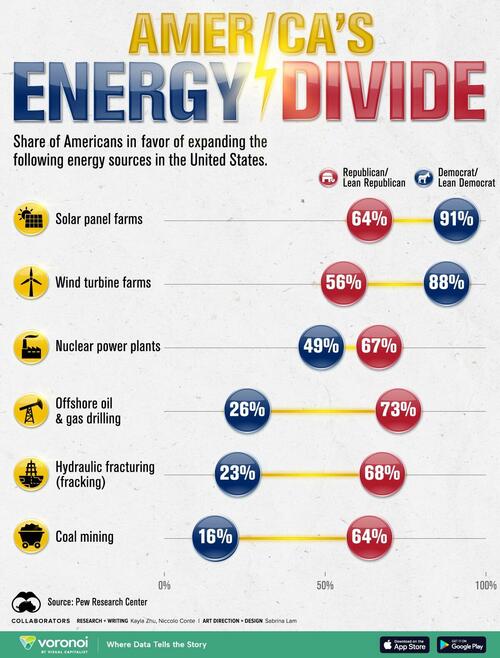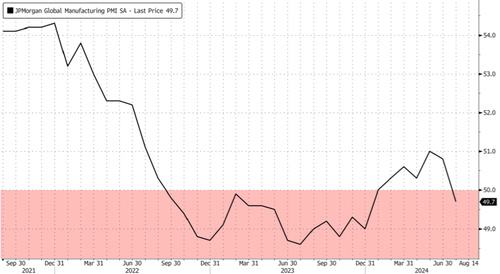Authored by Vince Bielski via RealClearInvestigations,
Jon Graft is on a mission to reignite the passion for learning by pushing a long-denigrated classroom practice: vocational education.

The superintendent of the Butler Tech District of high schools in Ohio is a leader in the growing movement to revive public education, marred by low test scores and high absenteeism, through a hands-on approach to learning that prepares students for careers in today’s tech-driven economy. Traditionally a means of funneling disadvantaged kids into outdated shop classes and dead-end jobs, vocational education is being reimagined by Graft and others in sophisticated career and technical education (CTE) programs nationwide, offering high school students of all academic abilities training in healthcare, computer science, engineering, skilled trades, and even the arts.
Butler Tech and other state-of-the-art CTE programs strive to keep students engaged with career-relevant coursework, apprenticeships, and internships, giving them direction and excitement about their futures. “We are changing the mindset of our communities,” Graft said. “They see that CTE is the way public education should be delivered to all high school students, not just a narrow demographic. It leads to a much higher trajectory in life, whether they go off to university or directly into the workforce.”
Big ideas to improve public education come and go like the flu, but CTE has established a notable track record, boosting student engagement, graduation rates, employment outcomes, and income, according to several studies. Butler Tech’s graduation rate of 98% is well above the average for Ohio and the nation, with 64% of graduates enrolling in two- and four-year colleges and other training.
As a new school year begins, the results explain why Butler Tech and programs in Connecticut and other states have waitlists while many traditional schools struggle to fill seats. Despite the demand, advocates say, programs are struggling to expand because the traditional school system continues to underfund CTE. Parrticularly in many wealthier districts, school leaders still consider career training as a less worthy Plan B for students who can’t handle the rigors of college.
The views of families, however, are changing. CTE is part of an ongoing sea change in education, which has seen a decade-long decline in college enrollment, particularly in the liberal arts. Some education scholars question the wisdom of having high schoolers focus on careers rather than the fundamental truths found in Great Books. But families that are switching to CTE say there’s no greater truth than a good job.
The soaring cost of college is helping drive the demand for career education. Families are rejecting the proposition that spending as much as $350,000 on a four-year degree is the only path to promising careers. Some CTE students have no desire to go to college and instead seek hands-on training in fields like manufacturing and auto repair that provide stable jobs. They prefer learning by doing, such as building an AI-powered robot, over reading a textbook about the birth of modern science in the 17th century. An increasing number of students are college-bound, using CTE to explore pathways in the biosciences and engineering to help make smarter financial decisions about their choice of universities and majors.
“In some places, CTE has been attracting a larger share of students who previously would have only taken conventional college preparatory coursework,” said Boston College’s Shaun Dougherty, a leading expert in the field. “They recognize that CTE is a chance to learn about applied pathways and can be a springboard to four-year colleges.”
That’s the case for Alliyah Newsome. Unhappy at her traditional high school, she transferred to Butler Tech near Cincinnati as a junior to figure out if nursing was the right path for her.
Her human-body systems and patient-care classes in the school’s healthcare science program, one of 31 career areas of study, were valuable. But the clincher for Newsome was the field experience: working in a hospital in her junior year, obtaining a nurse’s aide credential and then getting a job immediately after graduation at the prominent Cincinnati Children’s Hospital.
Newsome is now a nursing student at Miami University in Ohio with plans to get a master’s degree. “Butler confirmed for me that I want to become a nurse and spend thousands of dollars to get my degree,” she said. “This wouldn’t have happened without Butler.”
CTE’s Second-Class Status
The participation rate in CTE remains relatively low. In 2022, about 2.8 million secondary students, or 16% of the total, enrolled in a concentration of career courses, according to the U.S. Department of Education. Many students took these classes in their traditional high schools, which typically don’t offer the intensity and breadth of programs found in dedicated CTE centers like Butler Tech.
CTE advocates say the biggest challenge is that funding has not kept pace with demand. As many as 50% of all high schoolers would concentrate on CTE if more programs were available in their districts, estimates Catherine Imperatore, research and content director at the Association for Career and Technical Education. Her estimate is supported by a 2021 survey showing that 70% of Americans now have a positive view of vocational education.
Yet CTE remains on the sidelines because the traditional public school system continues to prioritize sending students to college, Imperatore says. The college-for-all mantra took hold in the 1980s as an idealistic response to the landmark “A Nation at Risk” report, which called for higher standards to fix the failing school system.
Since then, soaring student debt has made the push for a four-year degree harder to justify. As of July, 43 million borrowers held more than $1.6 trillion in outstanding federal student loans, or double the amount in 2010, according to the Education Data Initiative. That averages about $37,000 per student, not a small sum for a 22-year-old college graduate.
In recent years, lawmakers have buttressed career education as the need for skilled employees grows in healthcare, manufacturing, and other industries. New laws aim to improve the uneven quality of programs, requiring districts to report on student performance and making work-based learning, an essential piece of CTE, more accessible and credit-bearing.
But direct federal and state funding has only increased marginally over the last decade. Funding through the Perkins Act, the main source of federal support, has remained relatively flat since the 1990s and now sits at $1.44 billion, or about $100,000 per school district, enough to hire one or two teachers. When adjusted for inflation, the funding is below the 2004 level, according to Advance CTE, a non-profit that represents state leaders in the field.
“There’s always a push for increasing the investment,” said Emily Passias, the deputy executive director of Advance CTE. “We continue to see little baby-step increases over time that in no way outpaces the cost increases due to inflation.”
Most funding comes from states, which vary greatly in their support for career education. Although at least 27 states have boosted high school CTE funding in the last decade, the total investment was only $5.9 billion in 2022. That amounts to less than 1% of total state funding for K-12, well below the percentage of students who participate in career programs, according to the nonprofit group.
A handful of states, including Maryland, Oregon, and Wisconsin, provide no direct continuous support, leaving it to districts to decide if they want to run programs, sometimes with the aid of state grants, according to an Advance CTE report. But districts find expanding career education is a tough sell in many communities where families want to protect college-prep programming.
“School district budgets are typically a zero-sum game,” Boston College’s Dougherty said. “They have a fixed budget to work with. So choosing to add CTE programs invariably means cutting arts or world language programs. And that can be contentious.”
Ignite Pathways Takes Off
Ignite Pathways, a dedicated CTE school in Iowa, found a way to open in 2021 without the financial backing of nearby districts. Ignite rallied the support of rural Woodbine residents who wanted an alternative to traditional public education. They overwhelmingly passed a $3 million bond measure, and businesses in search of employees tossed in $9 million to help finance a new high-tech school building for Ignite.
“These are hardworking people who want education to be more relevant to give students skills that quickly make them productive members of society,” said Ignite Superintendent Justin Wagner. “The potential for students to be adrift after high school is a concern.”
Like many CTE schools, Ignite operates hand-in-hand with local businesses. The school set up programs in aviation, healthcare, business, and agricultural science after a feasibility study showed that these industries needed employees.
Students must take all the state-required core classes in math, English, and other subjects to graduate. But business leaders helped create new curricula that customized these courses to the needs of each program and also formed advisory committees to better link the school to the job market.
Wagner says an even bigger challenge was overcoming inflexible federal regulations that undermined the exploration of different careers by forcing students to make long-term commitments to a single apprenticeship. “We have challenged the system at every turn on behalf of the kids,” said Wagner, who expects at least 50% of his students to engage in some form of work-based learning in the new school year.
The superintendent says Ignite has given students a greater sense of purpose and self-direction, with about 60% of its graduates continuing their education at technical schools or colleges and 40% getting jobs.
Jordan Kerger is one of them. While a junior at a traditional high school, Kerger says he felt pressure to go to college, but then he enrolled in Ignite’s aviation program, with coursework in the flying environment, aircraft systems, and a flight simulator to teach the basics of flying.
Kerger was hooked. Next came live flight lessons to get a private pilot’s license and then two commercial licenses. He did enroll at the University of Nebraska for a semester but found he wasn’t interested in non-aviation coursework. So he went to Florida to train as a flight instructor, which will help him accumulate enough flight time to become a commercial airline pilot, an in-demand profession.
“Ignite gave me an early start right out of high school on what I really want to do, and that’s been great,” Kerger said. “I know others from school who still to this day don’t know what they want to do.”
CTE Waiting Lists Grow
In Oklahoma, career-based schools have to turn away hundreds of students like Kerger each year. The state is CTE-friendly, with a separate education department to oversee and fund its 29 dedicated centers, which also get support from traditional districts and local taxpayers. Yet at centers like Francis Tuttle, the waiting list to enroll is growing.
For the upcoming school year, Francis Tuttle will seat about 2,000 high school students and place 400 others on a waiting list even after recently expanding its automotive, medical, and cybersecurity programs and adding one for teacher preparation, says Superintendent Michelle Keylon. What’s also noteworthy is that most of the students are coming from wealthier suburbs, showing the changing demographics of CTE. Only about 40% of students are from low-income families, well below the state average.
Keylon says the sky-high cost of a college degree has made Francis Tuttle a better option for many families with high-performing kids. While college used to be the default plan for 90% of students in the area, she says, now families focus on what their kids want to do after high school and the best way to get there.
For college-bound students, Francis Tuttle lets them try out engineering, bioscience, and computer science to see what inspires them. Others opt for the school’s popular advanced manufacturing program, in which professionals from industries serve as guest lecturers and mentors and often offer students internships and jobs after graduation.
Among recent Francis Tuttle graduates, 74% continued to post-secondary education, and 22% found jobs. “I would love more funding because we can see results from the programming we already have in place,” said Keylon. “But our politicians don’t think that all students need access to CTE, so they don’t provide enough funding.”
CTE schools in Massachusetts and other states are also producing strong results. Boston College’s Dougherty co-authored a large study of Connecticut’s 16 dedicated CTE high schools where students take several career-focused courses over four years. Researchers found “robust positive effects” for male students of different socioeconomic backgrounds and abilities. They were 10 percentage points more likely to graduate and had 44% higher total earnings after graduation compared to a control group.
This year, a broader meta-analysis of CTE involving 28 studies across multiple states and types of programs also revealed benefits to students. Co-author Katherine Hughes of the CTE Research Network says their analysis showed large positive effects, particularly on high school graduation, two-year college enrollment, and employment, hammering home the point that CTE programs are a bright spot in the beleaguered public education system.
Where Career Ed Falls Short
To be sure, plenty of lackluster programs still exist that continue to give CTE a bad name. Researchers say some programs lack a sequence of courses that allow students to build skills in a particular field and don’t offer pathways that go beyond the basic trades. Others don’t provide work-based learning and connections to nearby college programs.
In New York City, a hotbed of CTE, Dougherty found “considerable variation” in the quality of the dedicated schools. Two high schools offered fewer than 4 CTE credits, and six failed to provide work-based learning in at least one grade.
“Overall, CTE programs may be more than halfway in their evolution to providing a high-quality education,” said Hughes.
Another concern is that the early focus on career skills denies students the chance to build more fundamental knowledge in math, science, and English that may be more helpful to their careers in the long term. CTE students fill their elective slots with career training rather than classes that develop basic analytical skills like classical philosophy or advanced math.
The risk is that CTE students are less adaptable to significant changes in the labor market, says Eric Hanushek, a prominent scholar of the economics of education at the Hoover Institution. His research of apprenticeship programs in Europe found that graduates eventually dropped out of the labor market a few decades later when their skills were no longer in demand.
“CTE makes the transition from high school to a job easier, but the concern is that they will have more difficulty adjusting to changes later in their careers,” Hanushek said.
Career education, however, might be just what traditional high schools need to bring students back to the classrooms and motivate them, says Dougherty. The strong demand from families is perhaps the best sign that CTE can provide a much-needed fix.
“The established evidence that CTE can engage students suggests that expanding high-quality programs could meet this need to reengage learners,” he said.



















